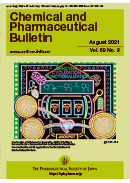
- |<
- <
- 1
- >
- >|
-
 Hidetoshi Tokuyama2021 年 69 巻 8 号 p. 707-716
Hidetoshi Tokuyama2021 年 69 巻 8 号 p. 707-716
発行日: 2021/08/01
公開日: 2021/08/01
ジャーナル フリー HTMLThis account summarizes the development of a benzyne-mediated cyclization/functionalization protocol for the versatile construction of highly substituted benzene derivatives fused with an N-heterocyclic ring such as indolines, indoles, and related nitrogen-containing heterocycles. The protocol comprises sequential reactions initiated by generating a benzyne species and subsequent cyclization via addition of magnesium amide to the benzyne, followed by trapping of the resultant magnesium compound in situ with various electrophiles. The substituent scope was expanded by conducting a transmetalation on a copper species to introduce alkyl, aryl, and alkenyl substituents. The utility of the sequential reaction was demonstrated in the synthesis of a carbazole natural product (heptaphylline), pyrrolo[4,3,2-de]quinoline alkaloids (batzellines), and pyrrolo[2,3-c]carbazole alkaloids (dictyodendrines).
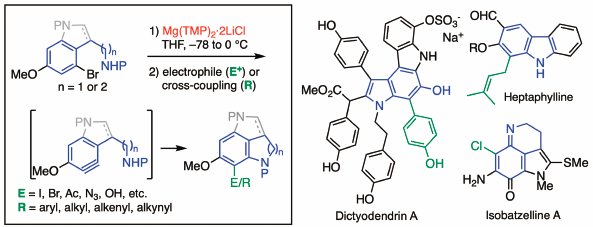 抄録全体を表示Editor's pick
抄録全体を表示Editor's pickThe cover figure schematically illustrates the divergent synthesis of various nitrogen-containing heteroaromatic marine natural products by benzyne-mediated cyclization / functionalization cascade reactions. The figure in the center is a slot machine, which represents the flask used in the Cascade reaction, showing that several coins with the structure of nitrogen-containing heteroaromatic complex marine natural products are popping out when three numbers 7 hit at the same time.
PDF形式でダウンロード (2023K) HTML形式で全画面表示
-
Takahiro Mori, Kiyofumi Wanibuchi, Hiroyuki Morita, Ikuro Abe2021 年 69 巻 8 号 p. 717-720
発行日: 2021/08/01
公開日: 2021/08/01
[早期公開] 公開日: 2021/05/29ジャーナル フリー HTML
電子付録Amide bond formation is one of the most fundamental reactions in organic chemistry, and amide bonds constitute the key functional groups in natural products, peptides, and pharmaceuticals. Here we demonstrate the chemoenzymatic syntheses of 4-coumaroyl- and hexanoyl-amino acids, using 4-coumarate: CoA ligase from the model plant Arabidopsis thaliana (At4CL2). At4CL2 accepts 4-coumaric acid and hexanoic acid as the carboxylate substrates to generate acyl adenylates, which are captured by the amino group of amino acids to afford a series of N-acyl amides. This study shows the potential of 4CL for application as a biocatalyst to generate a series of biologically active amide compounds.
 抄録全体を表示PDF形式でダウンロード (655K) HTML形式で全画面表示
抄録全体を表示PDF形式でダウンロード (655K) HTML形式で全画面表示
-
 Kazuki Akira, Ayaka Nohara, Yuka Utsunomiya, Hidemichi Mitome, Shinich ...2021 年 69 巻 8 号 p. 721-726
Kazuki Akira, Ayaka Nohara, Yuka Utsunomiya, Hidemichi Mitome, Shinich ...2021 年 69 巻 8 号 p. 721-726
発行日: 2021/08/01
公開日: 2021/08/01
ジャーナル フリー HTML
電子付録Hospital preparations are frequently prepared in Japanese hospitals when ready-made formulations to meet patients’ needs are unavailable. Although the quality of hospital preparations have to be ensured for efficacy and safety, such quality evaluation tends to be insufficient mainly due to lack of manpower and experimental environments in hospitals. In this paper, we investigated the applicability of quantitative (q)NMR spectroscopy to the quality control of diclofenac gargles as examples of hospital preparations, as it has various merits for the quantitative analysis of mixtures in solutions. Diclofenac gargles are composed of diclofenac, tranexamic acid, and lidocaine, and are used for the pain relief of stomatitis induced by cancer chemotherapy. Aliquots of the gargles, which were prepared five times, were mixed with dimethylsulfone as an internal standard, followed by qNMR measurements. Water signal suppression was achieved using a pulse program, water suppression enhanced through T1 effects, because the pulse program was superior to other ones such as presaturation and one-dimensional nuclear Overhauser effect spectroscopy in terms of quantitativeness. Concentrations of the three medicinal ingredients were simultaneously determined based on the signals selected by considering the spectral separation and the quantitativeness. Consequently, the gargles were found to be prepared with constant quality, and were stable at room temperature for at least four weeks. qNMR is considered to be potentially useful for the quality control of various hospital preparations because of minimal sample pretreatments, lack of need of calibration curves, and its comprehensive detection abilities.
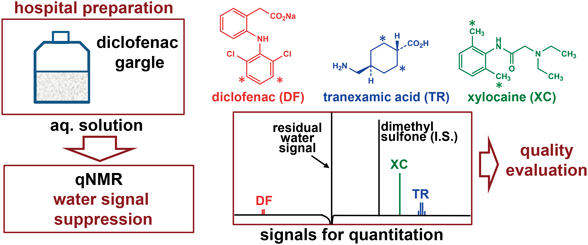 抄録全体を表示Editor's pick
抄録全体を表示Editor's pickHospital preparations are frequently prepared in Japanese hospitals, but quality evaluation is not necessarily sufficient. In this article, quantitative 1H NMR spectroscopy (qNMR) was applied to the quality evaluation of diclofenac gargles as an example of a hospital preparation. Aliquots of the gargles were analyzed by qNMR using an internal standard method, where the medicinal ingredients in the preparations were accurately and precisely determined, with the water signal being effectively suppressed by water suppression enhanced through T1 effects (WET). The quality and stability of the gargles were elucidated based on the results. As such, qNMR with WET is potentially useful for the quality control of various aqueous preparations because of its simplicity and convenience.
PDF形式でダウンロード (801K) HTML形式で全画面表示 -
Hiroaki Todo, Yuya Hasegawa, Akie Okada, Shoko Itakura, Kenji Sugibaya ...2021 年 69 巻 8 号 p. 727-733
発行日: 2021/08/01
公開日: 2021/08/01
ジャーナル フリー HTMLRecently, a novel humidifier that sprays water fine droplets equipped with a copolymer, poly(3,4-ethylene dioxythiophene)–poly(styrene sulfonate) (PEDOT/PSS) was developed. PEDOT/PSS in the humidifier absorbs water from the environment and releases fine water droplets by heating. In the present study, the effect of hydration on the skin barrier, stratum corneum, was first determined by the application of fine water droplets using the humidifier. The skin-penetration enhancement effect of a model hydrophilic drug, caffeine, was also investigated using the humidifier and compared with a conventional water-evaporative humidifier. More prolonged skin hydration effect was observed after application of the fine water droplet release humidifier using PEDOT/PSS than that using a conventional humidifier. In addition, markedly higher skin permeation of caffeine was observed in both infinite and finite dose conditions. Furthermore, higher skin permeation of caffeine from oil/water emulsion containing caffeine was observed in finite dose conditions by pretreatment with the humidifier using PEDOT/PSS. This device can provide water droplets without replenishing water, so it is more convenient for enhancing the skin permeation of chemical compounds from topical drugs and cosmetic formulations.
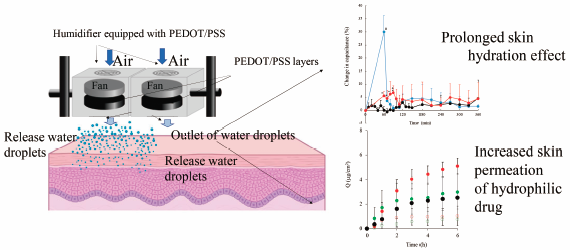 抄録全体を表示PDF形式でダウンロード (1430K) HTML形式で全画面表示
抄録全体を表示PDF形式でダウンロード (1430K) HTML形式で全画面表示 -
Kazuaki Fukushima, Hiroyoshi Esaki2021 年 69 巻 8 号 p. 734-740
発行日: 2021/08/01
公開日: 2021/08/01
ジャーナル フリー HTML
電子付録Peptide bond formation in living cells occurs at the peptidyl transferase center (PTC) of the large ribosomal subunit and involves the transfer of the peptidyl group from peptidyl-tRNA to aminoacyl-tRNA. Despite numerous kinetic and theoretical studies, many details of this reaction —such as whether it proceeds via a stepwise or concerted mechanism— remain unclear. In this study, we calculated the geometry and energy of the transition states and intermediates in peptide bond formation in the PTC environment using the ONIOM (our own n-layered integrated molecular orbital and molecular mechanics) method. The calculations indicated that the energy of the transition states of stepwise mechanisms are lower than those of concerted mechanisms and suggested that the reaction involves a neutral tetrahedral intermediate that is stabilized through the hydrogen-bonding network in the PTC environment. The results will lead to a better understanding of the mechanism of peptidyl transfer reaction, and resolve fundamental questions of the steps and molecular intermediates involved in peptide bond formation in the ribosome.
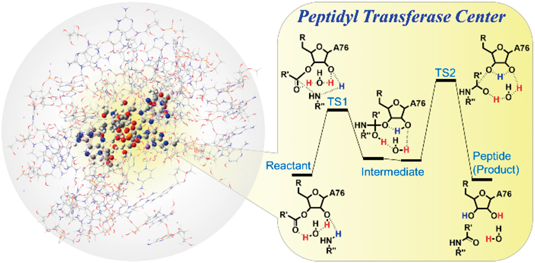 抄録全体を表示PDF形式でダウンロード (3529K) HTML形式で全画面表示
抄録全体を表示PDF形式でダウンロード (3529K) HTML形式で全画面表示 -
Takashi Tsujimoto, Ryoko Arai, Taichi Yoshitomi, Yutaka Yamamoto, Yosh ...2021 年 69 巻 8 号 p. 741-746
発行日: 2021/08/01
公開日: 2021/08/01
[早期公開] 公開日: 2021/05/21ジャーナル フリー HTML
電子付録Citrus-type crude drugs (CCDs) are commonly used to formulate decoctions in Kampo formula (traditional Japanese medicine). Our previous study reported metabolomic analyses for differentiation of the methanol extracts of Citrus-type crude drugs (CCDs) using ultra-HPLC (UHPLC)/MS, and 13C- and 1H-NMR. The present study expanded the scope of its application by analyzing four CCD water extracts (Kijitsu, Tohi, Chimpi, and Kippi); these CCDs are usually used as decoction ingredients in the Kampo formula. A principal component analysis score plot of processed UPLC/MS and NMR analysis data indicated that the CCD water extracts could be classified into three groups. The loading plots showed that naringin and neohesperidin were the distinguishing components. Three primary metabolites, α-glucose, β-glucose, and sucrose were identified as distinguishing compounds by NMR spectroscopy. During the preparation of CCD dry extracts, some compounds volatilized or decomposed. Consequently, fewer compounds were detected than in our previous studies using methanol extract. However, these results suggested that the combined NMR- and LC/MS-based metabolomics can discriminate crude drugs in dried water extracts of CCDs.
 抄録全体を表示PDF形式でダウンロード (2839K) HTML形式で全画面表示
抄録全体を表示PDF形式でダウンロード (2839K) HTML形式で全画面表示 -
 Daiki Tsuboi, Keita Kondo, Toshiyuki Niwa2021 年 69 巻 8 号 p. 747-759
Daiki Tsuboi, Keita Kondo, Toshiyuki Niwa2021 年 69 巻 8 号 p. 747-759
発行日: 2021/08/01
公開日: 2021/08/01
ジャーナル フリー HTMLThe particles of phenytoin (Phe), a poorly water-soluble model drug, were bead-milled alone or co-milled with a hydrophilic waxy additive using an ultra cryo-milling technique in liquid nitrogen (LN2) to improve its dissolution properties. However, the micronized drug particles adhered and aggregated, resulting in poor handling in manufacturing processes such as blending or tableting. To improve the dissolution profile and powder properties of the drug simultaneously, the milled products were secondarily processed together with larger spherical particles by mechanical powder processing. These secondary products were composite particles with a core-shell structure, with fine drug particles adhered and deposited on the core, based on order mixing theory. As a core, three types/sizes of spherical pharmaceutical excipient particles were applied. The resultant composite particles produced much faster release profiles than just milled or co-milled mixtures. In addition, the composite particles showed good micromeritic properties depending on the size of the core particles. These results indicate that the ultra cryo-milling and subsequent dry composite mixing is a potential approach for developing drug particles with improved dissolution.
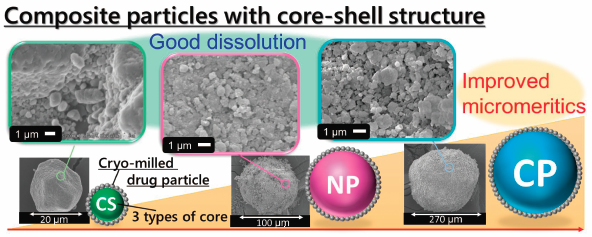 抄録全体を表示Editor's pick
抄録全体を表示Editor's pickThe authors have developed the novel composite ordered-mixed (OM) particles containing fine drug-particles. The composite OM particles were found to be double-structured spherical particles consisting of finely-milled particles layered around the core particles. It was also found that they have excellent characteristics from both pharmaceutical and micromeritic perspectives and could overcome manufacturing problems of solid dosage forms. Such unique OM particles could be precisely designed by ultra cryo-milling in liquid nitrogen and subsequent mechanical powder processing which would be a potential platform approach to develop the oral dosages (tablet, capsule, granule) with improved dissolution property of poorly water-soluble drugs.
PDF形式でダウンロード (4955K) HTML形式で全画面表示 -
Qianqian Sun, Shuyu Hu, Yu Song, Runqing Zhu, Luohao Li, Jing Li, Tao ...2021 年 69 巻 8 号 p. 760-767
発行日: 2021/08/01
公開日: 2021/08/01
ジャーナル フリー HTML
電子付録Daldinins are a novel type of naturally occurring tricyclic heterocycles isolated from Daldinia concentrica. In this study, four daldinin A derivatives with different alkyl side chains were synthesized using the same synthetic protocol. Bioactivity tests first indicated that the daldinin A derivatives showed significant protection for endothelial cells against damage caused by high glucose. The derivative compound with three carbon atoms on the alkyl side exhibited the best effect.
 抄録全体を表示PDF形式でダウンロード (2162K) HTML形式で全画面表示
抄録全体を表示PDF形式でダウンロード (2162K) HTML形式で全画面表示 -
Takayuki Shibata, Ryosuke Shimamura, Yuji Yamamoto, Hiroki Sakurai, Ju ...2021 年 69 巻 8 号 p. 768-772
発行日: 2021/08/01
公開日: 2021/08/01
ジャーナル フリー HTML
電子付録A facile and reliable fluorescence method for the quantification of urinary uracil concentration is proposed herein. The assay utilizes a specific fluorescence (FL) derivatization reaction for uracil using 3-methylbenzamidoxime as a fluorogenic reagent. Although the presence of urine inhibited the FL reaction, 10 µL of urine was sufficient for the detection of urinary uracil. The uracil derivative was successfully separated from other fluorescent impurities using simple reversed-phase LC with FL detection. Urinary uracil concentrations from 16 people were compared with the concentrations obtained by the traditional column-switching liquid chromatographic analysis with UV detection. The FL derivative of uracil appeared as a single peak in the chromatograms of all samples. However, several samples showed an additional peak overlapping the uracil peak when using the column-switching method because of UV-active impurities. These results indicated that that the present method is not affected by interfering substances in urine and affords a precise determination of urinary uracil. We expect the proposed method to be applicable for diagnosing dihydropyrimidine dehydrogenase deficiency in 5-fluorouracil chemotherapy.
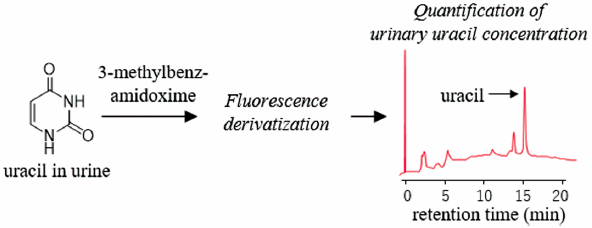 抄録全体を表示PDF形式でダウンロード (641K) HTML形式で全画面表示
抄録全体を表示PDF形式でダウンロード (641K) HTML形式で全画面表示 -
Go Yasuno, Hiroyuki Koide, Naoto Oku, Tomohiro Asai2021 年 69 巻 8 号 p. 773-780
発行日: 2021/08/01
公開日: 2021/08/01
ジャーナル フリー HTMLMultifunctional synthetic polymers can bind to target molecules and are therefore widely investigated in diagnostics, drug delivery carriers, and separation carriers. Because these polymers are synthesized from nonbiological components, purification processes (e.g., chromatography, dialysis, extraction, and centrifugation) must be conducted after the synthesis. Although several purification methods are used for polymer purification, few reports have revealed the influence of purification process on the functions of polymer. In this study, we demonstrated that the characteristics, function, and stability of synthetic polymer depend on the purification process. N-Isopropylacrylamide-based polymer nanoparticles (NPs) and melittin (i.e., honey bee venom) were used as a model of synthetic polymer and target toxic peptide, respectively. Synthesized NPs were purified by dialysis in methanol, acetone precipitation, or centrifugation. NPs purified by dialysis in ultrapure water were used as control NPs. Then, NP size, surface charge, toxin neutralization effect, and stability were determined. NP size did not considerably change by purification with centrifugation; however, it decreased by purification using dialysis in methanol and acetone precipitation compared with that of control NPs. The ζ-potential of NPs changed after each purification process compared with that of control NPs. The melittin neutralization efficiency of NPs depended on the purification process; i.e., it decreased by acetone precipitation and increased by dialysis in methanol and centrifugation compared with that of control NPs. Of note, the addition of methanol and acetone decreased NP stability. These studies implied the importance of considering the effect of the purification method on synthetic polymer function.
 抄録全体を表示PDF形式でダウンロード (4013K) HTML形式で全画面表示
抄録全体を表示PDF形式でダウンロード (4013K) HTML形式で全画面表示 -
Hitoshi Abe, Ishtiaq Jeelani, Atsuro Yonoki, Haruka Imai, Yoshikazu Ho ...2021 年 69 巻 8 号 p. 781-788
発行日: 2021/08/01
公開日: 2021/08/01
ジャーナル フリー HTML
電子付録A palladium-mediated intramolecular aryl–aryl coupling reaction was applied to the total synthesis of the bioactive natural products, graphislactone G (1), and palmariols A (2) and B (3), which possess an unusual chloro-subsutituent on the 6H-dibenzo[b,d]pyran-6-one skeleton. Based on the transition state model of the coupling reaction, the mechanistic aspect for the regioselectivity of the aryl–aryl coupling reaction is also discussed.
 抄録全体を表示PDF形式でダウンロード (790K) HTML形式で全画面表示
抄録全体を表示PDF形式でダウンロード (790K) HTML形式で全画面表示 -
Fumihiko Ogata, Noriaki Nagai, Shouko Iijima, Megumu Toda, Masashi Ota ...2021 年 69 巻 8 号 p. 789-795
発行日: 2021/08/01
公開日: 2021/08/01
ジャーナル フリー HTMLIn this study, the effect of contact time, temperature, pH, and coexistences on the adsorption of phosphate ions using the complex nickel–aluminum–zirconium hydroxide (NAZ) was evaluated. Moreover, the recovery of adsorbed phosphate ions from NAZ using desorption solution with different concentrations was demonstrated. The results showed that the quantity of phosphate ions adsorbed gradually increased with time, and the adsorption equilibrium was achieved within 24 h after adsorption. This kinetic data could be well described by the pseudo-second-order model with the correlation coefficient in the value of 0.997. Additionally, the quantity of phosphate which was adsorbed increased as temperature increased, and these results corresponded well with both the Langmuir, the correlation coefficient ranged from 0.920–0.949, and Freundlich models, the correlation coefficient ranged from 0.863–0.995. These results showed that the adsorption of phosphate ion was monolayer adsorption onto the NAZ surface. The optimal pH for removal of phosphate ions from aqueous media was during 4–8. In addition, chloride, nitrate, and sulfate ions did not significantly affect to the adsorption capability of phosphate ions in the complex solution system. Finally, the phosphate ions which were adsorbed onto NAZ could be recovered using sodium sulfate solution (recovery percentage: approx. 50% using sodium sulfate solution at 1000 mmol/L). These results highlight the potential of using NAZ as the cost-effectiveness adsorbent for phosphate ions removal from aqueous media.
 抄録全体を表示PDF形式でダウンロード (637K) HTML形式で全画面表示
抄録全体を表示PDF形式でダウンロード (637K) HTML形式で全画面表示 -
 Kazuki Matsuo, Takemasa Kondo, Eiji Yamaguchi, Akichika Itoh2021 年 69 巻 8 号 p. 796-801
Kazuki Matsuo, Takemasa Kondo, Eiji Yamaguchi, Akichika Itoh2021 年 69 巻 8 号 p. 796-801
発行日: 2021/08/01
公開日: 2021/08/01
ジャーナル フリー HTML
電子付録The irradiation of halogen-bonded complexes with light leads to the homolysis of carbon–halogen bonds and the formation of the corresponding carbon radical species. However, the only methodology reported for these halogen-bonding complexes is using CBr4 as the halogen-bond donor and its applicability is of great interest. In this study, the atom transfer radical addition (ATRA) reaction of olefins using bromomalonates as halogen-bonding donors was developed. Using 4-phenylpyridine as the halogen-bonding acceptor, the desired reaction proceeded well under external irradiation of 380 nm light to furnish the corresponding ATRA reaction product. The ATRA reaction was effective in generating the corresponding products for a variety of olefins. Furthermore, the ATRA reaction was applicable to bulky ketones, substrates, and malonate esters. The intermediates of the reaction were identified and a plausible reaction mechanism was proposed.
 抄録全体を表示Editor's pick
抄録全体を表示Editor's pickThe authors developed ATRA reactions of olefins with bromomalonate ester catalyzed by an in situ-formed halogen-bonding complex. The use of 4-phenylpyridine as the halogen-bonding acceptor, the desired reaction proceeded well under external irradiation of 380 nm LED light to furnish the corresponding ATRA reaction product. The substrate activation through the halogen bonding from the CT complex is a novel activation method that can be used for challenging synthetic routes since halogen bond acceptors such as pyridine are relatively inexpensive and readily available. This approach offers a new strategy for other classes of compounds for photocatalysis, including alkyl halides with amines or phosphine.
PDF形式でダウンロード (800K) HTML形式で全画面表示 -
Yuki Hitora, Kenta Ogura, Ahmed H. H. El-Desoky, Yuji Ise, Esther D. A ...2021 年 69 巻 8 号 p. 802-805
発行日: 2021/08/01
公開日: 2021/08/01
ジャーナル フリー HTMLA new rearranged nitrogenous bisabolone-type sesquiterpene, halichonic acid B (1), was isolated from a marine sponge Axinyssa sp. together with halichonic acid (2) and (6R,7S)-7-amino-7,8-dihydro-α-bisabolene (3). The structure of 1 was determined by extensive NMR and MS analyses, revealing an unprecedented carbon framework, and its absolute configuration was elucidated by time-dependent density-functional theory (TDDFT)-based electronic circular dichroism (ECD) spectrum calculation. We propose that 1 and 2 may be biosynthesized in the same pathway, involving the reaction between farnesyl pyrophosphate and glycine, followed by cyclization.
 抄録全体を表示PDF形式でダウンロード (564K) HTML形式で全画面表示
抄録全体を表示PDF形式でダウンロード (564K) HTML形式で全画面表示
-
Akinari Abe, Hiromichi Suzuki, Sayaka Amagai, Miyuki Saito, Shoko Itak ...2021 年 69 巻 8 号 p. 806-810
発行日: 2021/08/01
公開日: 2021/08/01
ジャーナル フリー HTMLEffect of rubbing application on the skin permeation of a hydrophilic drug caffeine (CAF) and lipophilic drug rhododendrol (RD) from lotion and cream were investigated. Skin permeation of CAF was markedly increased by rubbing action independent of the formulation type. In addition, the skin penetration-enhancement effect was affected by the rubbing direction: rubbing application against the direction of hair growth showed the highest permeation compared with rubbing applications along the direction of hair growth and in a circular pattern on the skin. On the other hand, no enhancement effect was observed by the rubbing actions on the skin permeation of RD, regardless of formulation type. Change in the infundibula orifice size of hair follicles by the rubbing and following skin stretching may be related to the higher skin permeation for CAF. In contrast, high RD distribution into the stratum corneum may be a reason why no enhancement effect was observed by the rubbing action. These results can be helpful to predict safety and effectiveness of topically applied formulations.
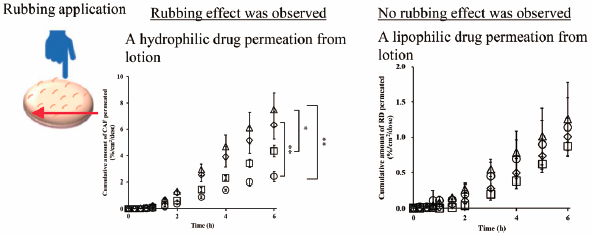 抄録全体を表示PDF形式でダウンロード (500K) HTML形式で全画面表示
抄録全体を表示PDF形式でダウンロード (500K) HTML形式で全画面表示 -
Jing Lu, Jin-Bu Xu, Xiaohuan Li, Xian-Li Zhou, Chungu Zhang, Feng Gao2021 年 69 巻 8 号 p. 811-816
発行日: 2021/08/01
公開日: 2021/08/01
ジャーナル フリー HTML
電子付録Three new aconitine-type C19-diterpenoid alkaloid namely novolunines A (1), B (2), and C (3), along with fifteen known diterpenoid alkaloids were isolated from the roots of Aconitum novoluridum, whose phytochemical investigations have never been reported before. The structures of three new alkaloids were established on the basis of spectra data (high-resolution electrospray ionization (HR-ESI)-MS, IR, one dimensional (1D)- and 2D-NMR). Noteworthily, novolunines A (1) and B (2) are two diterpenoid alkaloids bearing conformational isomerism. In addition, the diterpenoid alkaloids 1–3 did not show any anti-acetylcholinesterase (AChE) or anti-inflammatory activities.
 抄録全体を表示PDF形式でダウンロード (735K) HTML形式で全画面表示
抄録全体を表示PDF形式でダウンロード (735K) HTML形式で全画面表示
-
2021 年 69 巻 8 号 p. 817
発行日: 2021/08/01
公開日: 2021/08/01
ジャーナル フリー HTMLPDF形式でダウンロード (136K) HTML形式で全画面表示
- |<
- <
- 1
- >
- >|